 |
|

|
 |
TABLE of CONTENTS
 |
MnDOT plays lead role in developing first tribal training for state agencies |
By Rich Kemp
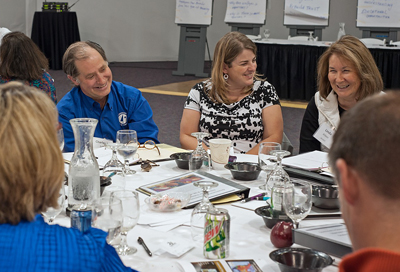
From left, Commissioner Charlie Zelle; Sheila Kauppi, Metro District South Area manager; and Linda Aitken, tribal liaison; discuss state agency and tribal relationships during the first Government to Government Tribal State training Oct. 9-10 in Red Wing. Photo by David Gonzalez |
State officials have long grappled with how to effectively communicate and interact with Minnesota Indian Tribal Nations. To help build better relationships between the state agencies and the tribes, the first Government to Government Tribal State training was held Oct. 9-10, hosted by the Prairie Island Indian Community.
The training grew out of the work of an advisory group of American Indian organizations and agency liaisons who provided the foundation, vision and parameters of needed work to ensure successful Tribal-State relations. MnDOT staff played a key role in planning the training. Linda Aitken, tribal liaison, led a group that consisted of the American Indian Advisory Council Group, the University of Minnesota-Duluth Continuing Education Office, members of the tribes and MnDOT employees Cindy Bellefeuille, training and development consultant; Lynn Geschwind, Affirmative Action Office director; and Rosemarie Merrigan, Diversity and Inclusion Programs manager.
“It is incredibly valuable to understand the history of the tribes and develop how we as an agency can cooperate, collaborate and build partnerships with each individual tribe,” said Commissioner Charlie Zelle.
More than 60 state agency and tribal leaders attended the 15-hour course, which included presentations from tribal leaders, state agency liaisons and UMD educators. The training covered:
- Federal and Minnesota American Indian history
- Understanding of Indian culture and traditions
- Increased understanding of sovereignty and a unique relationship between Tribal, State and Federal Governments
- Understanding how periods in Federal Indian Policy impact Tribal-State relations
- Understanding of the complexity of current issues that impact both Tribal and State Government
- Gaining skills in effectively consulting and building partnerships with Minnesota American Indian Nations
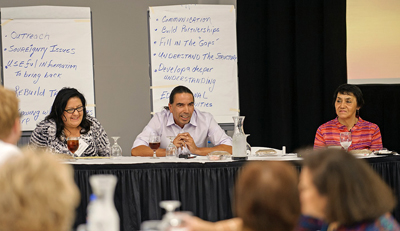
From left, Melanie Benjamin, Mille Lacs Band of Ojibwe chief executive; Kevin Jensvold, Upper Sioux Community chairman; and Dr. Erma Vizenar, White Earth Nation chairwoman; discuss building partnerships with the Minnesota Tribal Nations during the first Government to Government Tribal State training Oct. 9-10 in Red Wing. Photo by David Gonzalez |
“It has been a long time in coming,” said Aitken. “We have done a lot of developing and brainstorming… developing what the state agencies needed to know, the education, the culture, way of life.”
Minnesota is home to 11 sovereign tribal nations, which collectively represent the sixth largest employer in the state and the majority of the state’s 61,000 American Indians. Tribal jurisdiction affects thousands of acres of land within reservation boundaries and ceded territories.
“The tribes are similar in many ways, but there are distinct differences,” said Kevin Jensvold, Upper Sioux Community chairman. “The agencies need to put in the effort to get to know the leaders of the tribes, get to know how they function and what their needs are.”
“You can understand the tribes through partnerships,” said Melanie Benjamin, Mille Lacs Band of Ojibwe chief executive. “Visit the reservations to understand how we operate and govern… listening is important.”
The training will be offered throughout the year to state agency staff who work directly with tribes or make decisions affecting tribal nations or American Indians. The goal is to build respectful relationships between the state and tribes and to create an enduring commitment by the state to learn about tribal governments.
“It went exceptionally well,” said Aitken. “However, this is just the beginning. There is more training being developed…working with tribes to develop protocol, and understanding tribal laws and sensitive issues.”
|
 |
|

|
 |
TABLE of CONTENTS
 |
Donated vacation hours sought for Marvin Carlson |
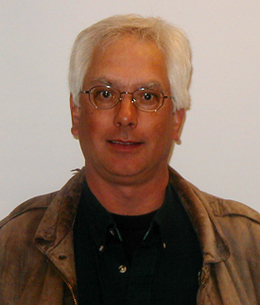
Marv Carlson, Duluth Field Construction Office, has been approved for the vacation donation program. Photo by Jessica Leslie |
Marv Carlson, Duluth Field Construction Office, has exhausted all his sick and vacation leave due to a life- threatening medical condition. He is unable to work and has been approved as a recipient under the state’s vacation donation program.
Carlson has worked in field construction for more than 28 years and needs your support during this difficult time.
The state vacation donation program allows employees to donate up to 40 hours vacation per fiscal year to approved recipients.
To donate vacation leave:
- Go to Employee Self Service Website, click on “Other Payroll,” then “Leave Donations.”
- Select the magnifying glass next to “Reserve Bank” and choose Carlson’s/Bennett’s name.
- Enter the number of hours you wish to donate
- Click on the yellow “Save” box
Donation forms also are available from your Payroll or Human Resources office or at www.mmb.state.mn.us/doc/vacation/pe665.pdf. |
 |
|

|
 |
TABLE of CONTENTS
 |
Open enrollment for employee insurance benefits begins Nov. 1 |
|
By Sue Roe

Changes can be made to the State Employee Group Insurance program Nov. 1-14. |
Employees who want to make changes to their benefits can do so during open enrollment, Nov. 1-14. Open enrollment meetings started this week throughout the state and will continue through Oct. 25.
Employees may attend any open enrollment meeting during October, even those scheduled at other agencies. Here is a complete list of meeting dates and locations.
This year’s open enrollment allows employees to change their medical and dental insurance carriers and add or drop dependent coverage. Employees also may enroll in or increase long-term disability, child life insurance, pre-tax plans and reduce the elimination period by one 30-day unit for the Manager’s Income Protection Plan.
Employees currently participating in the pre-tax plans for medical and dental expense accounts, dependent care expense accounts and the transit expense account must re-enroll for 2014.
During open enrollment, employees can also sign up for a StayWell Health Assessment, which includes completing a personal health assessment and accepting a health coach call to receive lower office visit copayments in 2014. Register for an account with StayWell now and complete the personal health assessment during the open enrollment period.
Connie Eystad, HR transaction benefits supervisor, said some benefits are not open every year. For example, dental benefits are open every other year.
“It’s very important to attend an open enrollment meeting to see what’s new and open for changes,” Eystad said. “We also encourage everyone to read the emails the Human Resource benefit staff will send during the open enrollment period. These emails will have tips and reminders to help guide employees to a successful open enrollment period.”
Eystad also said employees were mailed a SEGIP Report newsletter to their home addresses explaining the benefits open for enrollment Nov. 1-14.
For more information about open enrollment, contact Deborah Staples, 651-366-3405, Julie Gore, 651-366-3376, or Connie Eystad, 651-366-3398. |
 |
|
|

|
 |
TABLE of CONTENTS
 |
Mississippi River Trail signage between Hastings, Iowa border completed |
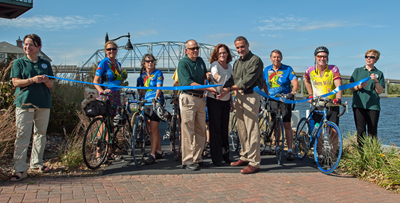
Members of the Wabasha Bicycle Club and representatives of the Mississippi River Parkway Commission of Minnesota, the U.S. National Park Service, Mississippi River Trail, Inc., and other supporters joined MnDOT Oct. 2 to celebrate the MRT milestone at the National Eagle Center in Wabasha. MnDOT staff pictured are, at far left, Carol Zoff, Office of Environmental Stewardship, and Amr Jabr, Engineering Services Division assistant director, at center right. Photo by David Gonzalez |
By TK Kramascz
MnDOT has completed the first installation of guidance signage on a segment of the 10-state Mississippi River Trail between Hastings, Minn., and the Iowa border.
Many partners, including MnDOT, the Mississippi River Parkway Commission of Minnesota, the U.S. National Park Service, Mississippi River Trail, Inc., and representatives from several cities and counties, celebrated the milestone with other project supporters at a ribbon-cutting event at the National Eagle Center in Wabasha on Wednesday, Oct. 2.
The first of a three-year signing effort, phase one was completed between August and September 2013 and directs bicyclists along 148 miles between Hastings and the Iowa border. Signs along the Hastings to Elk River segment of the bikeway will be installed in 2014, and the segment between Elk River and Lake Itasca in 2015.
Minnesota’s segment of the Mississippi River Trail follows the river roughly 600 miles from its source at Itasca State Park to the Iowa border. Located largely on road shoulders, the route also includes segments of scenic state, regional and local trails. Minnesota’s route, sometimes on both sides of the river, totals more than 800 miles.
In 2012 the Minnesota Legislature designated the Mississippi River Trail as Minnesota’s first state bikeway under the commissioner of transportation. The route was also designated as U.S. Bicycle Route 45, Minnesota’s first bikeway in this national network. The new MRT signs allow bicyclists to confidently follow a marked route so they can enjoy the Mississippi River Trail as it winds through a river landscape filled with natural, cultural and recreational amenities.
The Oct. 2 event was hosted by the National Eagle Center in Wabasha, one of more than 70 interpretive center located on the banks of the Mississippi.
The event also coincided with the 75th anniversary of the Great River Road, a parkway celebrating the Mississippi River that was conceived in 1938 by the governors of the 10 river states and envisioned as a continuous byway network of existing roads. |
 |
|

|
 |
TABLE of CONTENTS
 |
Concrete certification course to be offered online |
|
By Nick Busse, Research Services
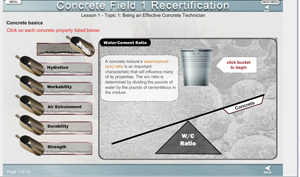
The concrete technician certification/recertification training will be offered as an online course. |
Beginning Nov. 1, MnDOT’s Concrete Field Level I technician certification/re-certification training will be offered as an interactive, online course.
The new E-Learning module will provide an alternative to the eight-hour, classroom-based training. The goal is to allow MnDOT personnel, city and county staff and others to re-certify without incurring unnecessary travel costs and lost work time. In addition, students will now be able to work at their own pace, which could lead to better learning outcomes.
“They can go back into this over and over again until they really understand the material versus taking the course in the traditional classroom setting,” said John Micheau, MnDOT technical certification specialist.
The online course will take approximately six hours to complete, after which learners will be given one hour to complete the 50-question recertification exam. The course and exam must be completed by April 30. Certification cards will be issued as a batch in June.
The project to move the certification course online was funded by the Local Road Research Board. Micheau said city and county engineers would like to avoid sending personnel to a one-day class that could involve traveling long distances and staying overnight at a hotel. He estimates that between 150 and 200 will take the class each year.
In addition to being more cost-efficient, Micheau believes the online course is more attuned to the needs of a younger generation.
“We’re trying to do this for all of our recertification courses. We just think this is the wave of the future,” he said.
Students can get more information by visiting the technical certification website. They can also visit the Aggregate & Ready Mix Association of Minnesota website to register for classes. Classroom training is $200 and on-line training is $250. |
 |
|

|
|

|
 |
TABLE of CONTENTS
 |
MnDOT receives Minnesota Preservation Award |
By Rich Kemp
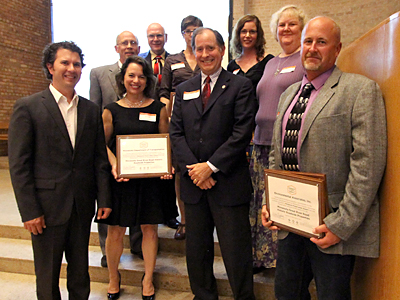
MnDOT, the Mississippi River Parkway Commission and several partners received the Minnesota Preservation Award from the Preservation Alliance of Minnesota at a ceremony Sept. 27 at Christ Church Lutheran in Minneapolis. From left: Todd Grover, MacDonald and Mack Architecture; Rep. Sheldon Johnson, Mississippi River Parkway Commission chair; Carol Zoff, MnDOT; Tom Vesley, MnDOT; Amy Meller, MacDonald and Mack Architecture; Charlie Zelle, MnDOT; Angie Wolf Scott, MacDonald and Mack Architecture; Betty Buckley, MnDOT; and Ray Stenglein, Environmental Associates. Photo courtesy of the Preservation Alliance of Minnesota |
The Preservation Alliance of Minnesota Sept. 27 presented MnDOT with a 2013 Minnesota Preservation Award for the Great River Road Historic Property Restorations.
“This is great affirmation for MnDOT, all the CO and District contributors, and Carol Zoff for the heavy workload, responsibility, project management, collaboration and trouble-shooting in the successful delivery of the legislative funding and GRR Historic Property Restorations,” said Scott Bradley, Context Sensitive Solutions director.
Zoff, senior landscape architect, worked with the Mississippi River Parkway Commission and several partners to preserve sites along the Great River Road.
“I really appreciate the MN-MRPC for identifying a need, prioritizing it, championing to secure funding, leveraging assistance to deliver, coaching along the way and promoting the results,” said Zoff, senior landscape architect.
This was the 29th year of the Minnesota Preservation Awards. More than 30 award nominations were submitted this year.
“The response to our call for nominations continues to demonstrate that preserving our heritage is a value across the state,” said Will O’Keefe, Preservation Alliance of Minnesota. “Our jury had much discussion and debate in choosing the projects that best fulfilled the judging criteria.”
|
 |
|

|
 |
TABLE of CONTENTS
 |
Dellwo, Lovness recognized by NBAA |
By Dan McDowell, Office of Aeronautics
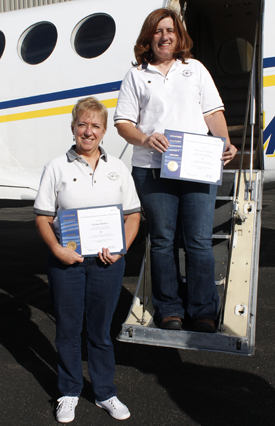
From left, Vee Dellwo and Barbara Lovness were recognized for their excellence by the National Business Aviation Association. Photo by Dan McDowell |
Office of Aeronautics Air Transportation Specialists Vee Dellwo and Barbara Lovness were recognized for their excellence by the National Business Aviation Association. Dellwo received her award for more than 21 years of service, while Lovness was recognized for her nine years of service.
The NBAA granted the ‘Aviation Support Services Safety Awards’ for consistent contributions to the safety of business aircraft operations. The award highlights the number of years each recipient has contributed to the safe operation of the aircraft and the years without accident or injury to property or persons. Along with a number of other duties, Dellwo and Lovness are responsible for the scheduling of Aeronautics aircraft.
“We are very proud of Vee and Barb not only for their contributions to our continued safe operations, but also for their dedication to excellence across the board, as well as for their passion for aviation,” said Aeronautics Chief Pilot Barry Erickson. “They are critically important members of our team and we are thrilled that they were recognized by the NBAA.” |
 |
|

|
 |
TABLE of CONTENTS
 |
Minnesota GO tells transportation system story, makes case for long-term, stable funding |
By Commissioner Charlie Zelle

Commissioner Charlie Zelle engages the audience in a discussion of long-term transportation and funding needs at one of the many town hall meetings MnDOT is coordinating in communities statewide this fall. Photo by David Gonzalez |
I want to fill you all in on an important effort I’ve been involved with during the last few months.
It’s an information and outreach program called Minnesota GO, and it’s an effort to carry a message to the citizens of Minnesota about the state’s transportation system, its status, its needs and what the future holds for it.
I’ve been in a number of communities across Minnesota, holding town hall meetings, speaking with local officials and the news media. I explain the importance of transportation in everyone’s everyday life. And I point out how important it is to the state’s economy.
Transportation plays an integral role in Minnesota’s economic vitality. It is a network of modes and options. It’s how people get to work. It’s the pathway for manufacturers to haul in raw materials and push out their products. It’s how our grocery stores get the produce and breakfast cereal we eat every day.
It also has a significant impact on our quality of life. If the road is smooth and congestion is minimal, it can reduce stress in our lives. If we have transit options available, or if we have good bike routes available for our daily commutes, we have a better quality of life. Good roads save us money by reducing wear and tear on our vehicles as well as by limiting the amount of fuel we use idling in a traffic backup. If our transportation system is functioning well, it is safe. Safety is indeed a key element in how well we believe our lives are going.
Right now, Minnesota’s transportation system is above average. Our bridges are in pretty good shape and our pavements are holding their own. But, they are aging. More than half of MnDOT pavements and 35 percent of its bridges are more than 50 years old. We do a good job of maintaining those pieces of infrastructure, but as it ages, the costs increase.
We see ongoing needs to improve transit in Greater Minnesota and the Twin Cities metro area. And the public is also very interested in having good bike paths, pedestrian walkways and accessible intersections so everyone can move freely and safely.
Minnesota has a lot invested in its transportation system. For instance, 80 percent of the state’s assets are in roads and bridges. There are more than 140,000 miles of state, county, city and township roads. Minnesota has about 20,000 bridges that are 10 feet or longer, 4,458 miles of rail road, 135 public airports and nine shipping ports.
We are about to release our latest Minnesota State Highway Investment Plan. MnSHIP looks out 20 years. It evaluates our road and bridge system, calculates the revenue and determines what priorities we’ll need to address in order to meet our transportation system goals.
In developing that plan, we’ve discovered that, because of increasing inflation and decreasing revenues, Minnesota will have about $18 billion to spend on roads and bridges alone during the next two decades. That amount will not allow us to maintain our infrastructure at the level we are at today. We will need an additional $5 billion for that. And, if we want to continue to achieve our transportation vision during the next 20 years so that it continues to support the state’s economy and quality of life, we will need $12 billion.
MnSHIP lays out modest improvements and solid maintenance in the first 10 years, and a significant decrease in maintenance and no improvements in the second decade. This is due to inflation eating into what we can purchase and faster deterioration of the system.
The MnSHIP plan is a resource-constrained plan. But, it is not MnDOT’s vision. I make that point at every town hall meeting.
When I ask town hall attendees if they think the system is important, they agree that it is. Often, they ask what it will take to keep transportation viable. I talk about the Governor’s Transportation Finance Advisory Committee that met last year and identified a similar need. TFAC also offered up some funding solutions that involved different ways of gathering revenue, including a fuel tax increase, a sales tax increase and wheelage taxes.
Take the fuel tax. If you have a car that gets 22 miles per gallon and you drive 15,000 miles a year, you use about 680 gallons of gas annually. If you paid a dime more a gallon, you’d pay an additional $68 a year. That’s less than $6 a month, or $1.50 a week, about the price of a cup of coffee. That’s not a huge investment to ensure our transportation future.
And for that cup of coffee a week, that fuel tax increase would provide about $308 million a year, or about $6 billion over 20 years.
MnDOT has shown it can make good use of additional funding. In 2008, the state Legislature passed a fuel tax increase that allowed us to repair or replace 172 bridges, repave many miles of roadway and replace a number of interchanges. As an agency, it is vital that we be transparent about how we spend money and why we spend it where we do. It is a key goal for me and you will hear more about that soon.
The state Legislature determines how to best raise revenue. And its members have shown great interest in what we are doing. Many attend the town hall meetings and listen to the citizens and business owners they represent say that transportation funding is a very important issue to Minnesotans and their communities.
As employees of MnDOT, you understand better than most the importance of stable and long-term funding. I ask you as well to continue to tell the transportation story. If we work together on this, we can help build a bright future for our transportation system.
If you want to learn more about Minnesota GO, look at this website at www.minnesotago.org. |
 |
|
______________________________________________________________________________ -->
| |
|



